Search
- Page Path
- HOME > Search
- [Korean]
- The Microstructure and Mechanical Properties of Y2O3-Dispersed Fe-C and Fe-CNT Sintered Steels
- Jin Young Lim, Jung-Ho Ahn
- J Korean Powder Metall Inst. 2017;24(4):298-301. Published online August 1, 2017
- DOI: https://doi.org/10.4150/KPMI.2017.24.4.298

- 420 View
- 1 Download
-
 Abstract
Abstract
 PDF
PDF In the present work, we use multiwall carbon nanotubes (MWCNT) as the starting material for the fabrication of sintered carbon steel. A comparison is made with conventionally sintered carbon steel, where graphite is used as the starting material. Milling is performed using a horizontal mill sintered in a vacuum furnace. We analyze the grain size, number of pores, X-ray diffraction patterns, and microstructure. Changes in the physical properties are determined by using the Archimedes method and Vickers hardness measurements. The result shows that the use of MWCNTs instead of graphite significantly reduces the size and volume of the pores as well as the grain size after sintering. The addition of Y2O3.to the Fe-MWCNT samples further inhibits the growth of grains.
- [English]
- Expansion of Multi-wall Carbon Nanotubes and its Lithium Storage Property
- Jung-Ho Ahn, Jeong-Seok Ahn
- J Korean Powder Metall Inst. 2017;24(4):275-278. Published online August 1, 2017
- DOI: https://doi.org/10.4150/KPMI.2017.24.4.275
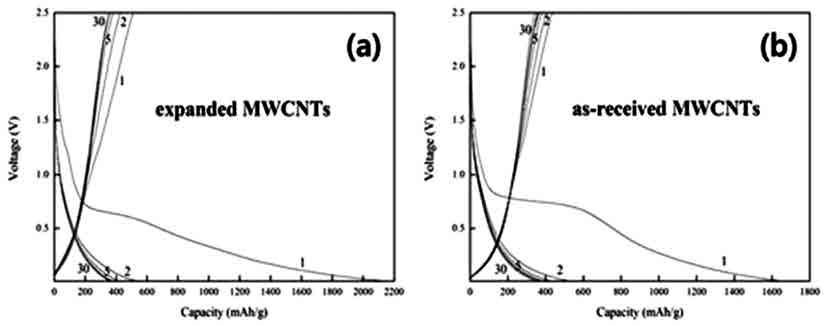
- 542 View
- 2 Download
-
 Abstract
Abstract
 PDF
PDF In the present work, we apply a technique that has been used for the expansion of graphite to multiwall carbon nanotubes (MWCNT). The nanotubes are rapidly heated for a short duration, followed by immersion in acid solution, so that they undergo expansion. The diameter of the expanded CNTs is 5-10 times larger than that of the asreceived nanotubes. This results in considerable swelling of the CNTs and opening of the tube tips, which may facilitate the accessibility of lithium ions into the inner holes and the interstices between the nanotube walls. The Li-ion storage capacity of the expanded nanotubes is measured by using the material as an anode in Li-ion cells. The result show that the discharge capacity of the expanded nanotubes in the first cycle is as high as 2,160 mAh/g, which is about 28% higher than that of the un-treated MWCNT anode. However, the charge/discharge capacity quickly drops in subsequent cycles and finally reaches equilibrium values of ~370 mAh/g. This is possibly due to the destruction of the lattice structures by repeated intercalation of Li ions.
- [English]
- Fabrication and Mechanical Characteristics of Bulk Nickel/Carbon Nanotube Nanocomposites via the Electrical Explosion of Wire in Liquid and Spark Plasma Sintering Method
- Thuyet-Nguyen Minh, Hai-Nguyen Hong, Won Joo Kim, Ho Yoon Kim, Jin-Chun Kim
- J Korean Powder Metall Inst. 2016;23(3):213-220. Published online June 1, 2016
- DOI: https://doi.org/10.4150/KPMI.2016.23.3.213
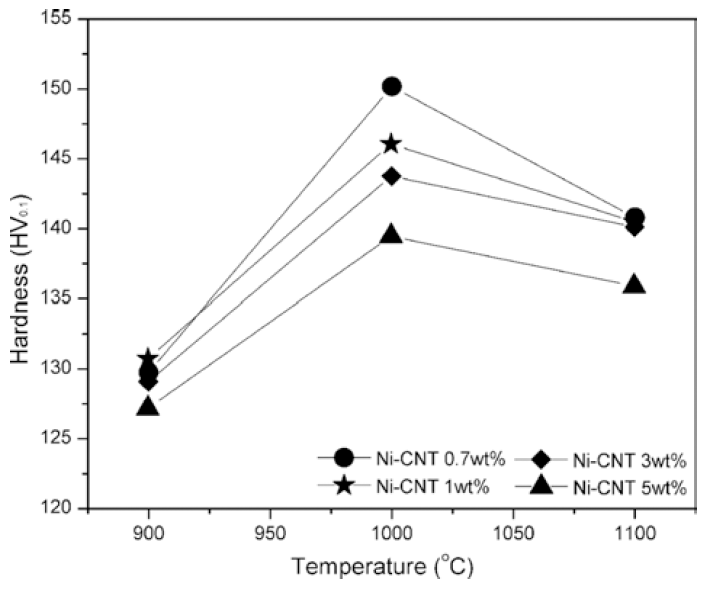
- 807 View
- 1 Download
- 2 Citations
-
 Abstract
Abstract
 PDF
PDF In this study, bulk nickel-carbon nanotube (CNT) nanocomposites are synthesized by a novel method which includes a combination of ultrasonication, electrical explosion of wire in liquid and spark plasma sintering. The mechanical characteristics of the bulk Ni-CNT composites synthesized with CNT contents of 0.7, 1, 3 and 5 wt.% are investigated. X-ray diffraction, optical microscopy and field emission scanning electron microscopy techniques are used to observe the different phases, morphologies and structures of the composite powders as well as the sintered samples. The obtained results reveal that the as-synthesized composite exhibits substantial enhancement in the microhardness and values more than 140 HV are observed. However an empirical reinforcement limit of 3 wt.% is determined for the CNT content, beyond which, there is no significant improvement in the mechanical properties.
-
Citations
Citations to this article as recorded by- Fabrication of nanocomposites by electric explosion of stainless steel capillaries filled with carbon nanotubes
Tao Jiang, Zhongyu Hou
Applied Surface Science.2020; 513: 145824. CrossRef - Effect of a nano-sized TiC particle addition on the flow-assisted corrosion resistance of SA 106B carbon steel
Jin-Ju Park, Eun-Kwang Park, Gyoung-Ja Lee, Chang-Kyu Rhee, Min-Ku Lee
Applied Surface Science.2017; 415: 143. CrossRef
- Fabrication of nanocomposites by electric explosion of stainless steel capillaries filled with carbon nanotubes
- [Korean]
- Powder Sintering Characteristics of Carbon Nanotubes Reinforced SKD11 Tool Steel Sintered by Spark Plasma Sintering
- Je-Se Moon, Sung-Sil Jung, Dae-Yeol Lee, Young-Keun Jeong, Myung Chang Kang, Chun-Dal Park, Kook-Tae Youn
- J Korean Powder Metall Inst. 2015;22(3):157-162. Published online June 1, 2015
- DOI: https://doi.org/10.4150/KPMI.2015.22.3.157
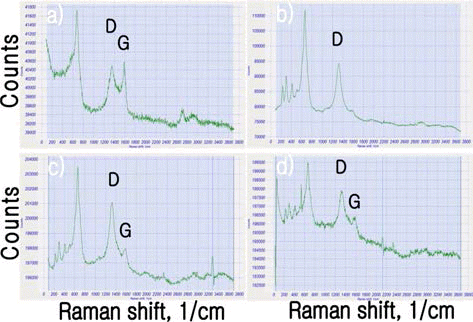
- 577 View
- 3 Download
- 1 Citations
-
 Abstract
Abstract
 PDF
PDF SKD11 (ASTM D2) tool steel is a versatile high-carbon, high-chromium, air-hardening tool steel that is characterized by a relatively high attainable hardness and numerous, large, chromium rich alloy carbide in the microstructure. SKD11 tool steel provides an effective combination of wear resistance and toughness, tool performance, price, and a wide variety of product forms. Adding of CNTs increased the performance of mechanical properties more. 1, 3 vol% CNTs was dispersed in SKD11 matrix by mechanical alloying. SKD11 carbon nanocomposite powder was sintered by spark plasma sintering process. FE-SEM, HR-TEM and Raman analysis were carried out for the SKD11 carbon nanocomposites.
-
Citations
Citations to this article as recorded by- Study on Effects of Mold Temperature on the Injection Molded Article
J.-H. Han, Y.-C. Kim
Archives of Metallurgy and Materials.2017; 62(2): 1271. CrossRef
- Study on Effects of Mold Temperature on the Injection Molded Article
- [Korean]
- Microstructure and Mechanical Properties of CNT/Al Composite Fabricated by a Powder-in-Sheath Rolling Method utilizing Copper Tube as a Sheath
- Seong-Hee Lee
- J Korean Powder Metall Inst. 2014;21(5):343-348. Published online October 1, 2014
- DOI: https://doi.org/10.4150/KPMI.2014.21.5.343
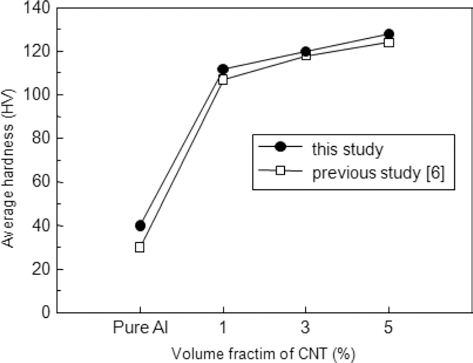
- 474 View
- 0 Download
-
 Abstract
Abstract
 PDF
PDF A powder-in-sheath rolling (PSR) process utilizing a copper alloy tube was applied to a fabrication of a multi-walled carbon nanotube (CNT) reinforced aluminum matrix composite. A copper tube with an outer diameter of 30 mm and a wall thickness of 2 mm was used as a sheath material. A mixture of pure aluminum powders and CNTs with the volume contents of 1, 3, 5 vol% was filled in the tube by tap filling and then processed to 93.3% height reduction by a rolling mill. The relative density of the CNT/Al composite fabricated by the PSR decreased slightly with increasing of CNTs content, but showed high value more than 98%. The average hardness of the 5%CNT/Al composite increased more than 3 times, compared to that of unreinforced pure Al powder compaction. The hardness of the CNT/Al composites was some higher than that of the composites fabricated by PSR using SUS304 tube. Therefore, it is concluded that the type of tube affects largely on the mechanical properties of the CNT/Al composites in the PSR process.
- [Korean]
- Fabrication and Evaluation of Carbon Nanotube Reinforced Al Matrix Composite by a Powder-in-sheath Rolling Method
- Seong-Hee Lee, Dongmin Hong
- J Korean Powder Metall Inst. 2014;21(1):50-54. Published online February 1, 2014
- DOI: https://doi.org/10.4150/KPMI.2014.21.1.50
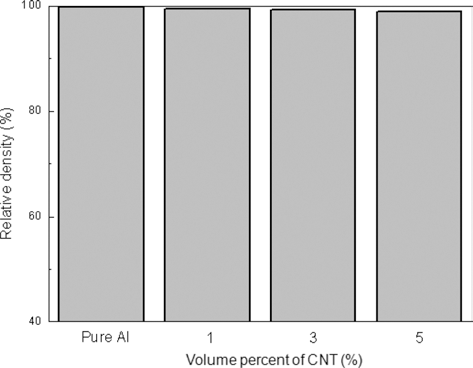
- 571 View
- 0 Download
- 5 Citations
-
 Abstract
Abstract
 PDF
PDF A powder-in-sheath rolling method was applied to a fabrication of a carbon nano tube (CNT) reinforced aluminum composite. A STS304 tube with an outer diameter of 34 mm and a wall thickness of 2 mm was used as a sheath material. A mixture of pure aluminum powders and CNTs with the volume contents of 1, 3, 5 vol was filled in the tube by tap filling and then processed to 73.5% height reduction by a rolling mill. The relative density of the CNT/ Al composite fabricated by the powder-in-sheath rolling decreased slightly with increasing of CNTs content, but exhibited high value more than 98. The grain size of the aluminum matrix was largely decreased with addition of CNTs; it decreased from 24 μm to 0.9 μm by the addition of only 1 volCNT. The average hardness of the composites increased by approximately 3 times with the addition of CNTs, comparing to that of unreinforced pure aluminum. It is concluded that the powder-in-sheath rolling method is an effective process for fabrication of CNT reinforced Al matrix composites.
-
Citations
Citations to this article as recorded by- Torsion Property of the Structure Bonded Aluminum Foam Due to Impact
G.W. Hwang, J.U. Cho
Archives of Metallurgy and Materials.2017; 62(2): 1353. CrossRef - A Fatigue Fracture Study on TDCB Aluminum Foam Specimen of Type Mode III Bonded with Adhesive
J.H. Lee, J.U. Cho
Archives of Metallurgy and Materials.2017; 62(2): 1359. CrossRef - Experimental Study On Fracture Property Of Double Cantilever Beam Specimen With Aluminum Foam
Y.C. Kim, H.K. Choi, J.U. Cho
Archives of Metallurgy and Materials.2015; 60(2): 1151. CrossRef - Experimental Study On Fracture Property Of Tapered Double Cantilever Beam Specimen With Aluminum Foam
Y.C. Kim, S.S. Kim, J.U. Cho
Archives of Metallurgy and Materials.2015; 60(2): 1459. CrossRef - Microstructure and Mechanical Properties of CNT/Al Composite Fabricated by a Powder-in-Sheath Rolling Method utilizing Copper Tube as a Sheath
Seong-Hee Lee
Journal of Korean Powder Metallurgy Institute.2014; 21(5): 343. CrossRef
- Torsion Property of the Structure Bonded Aluminum Foam Due to Impact
TOP
 kpmi
kpmi


 First
First Prev
Prev


